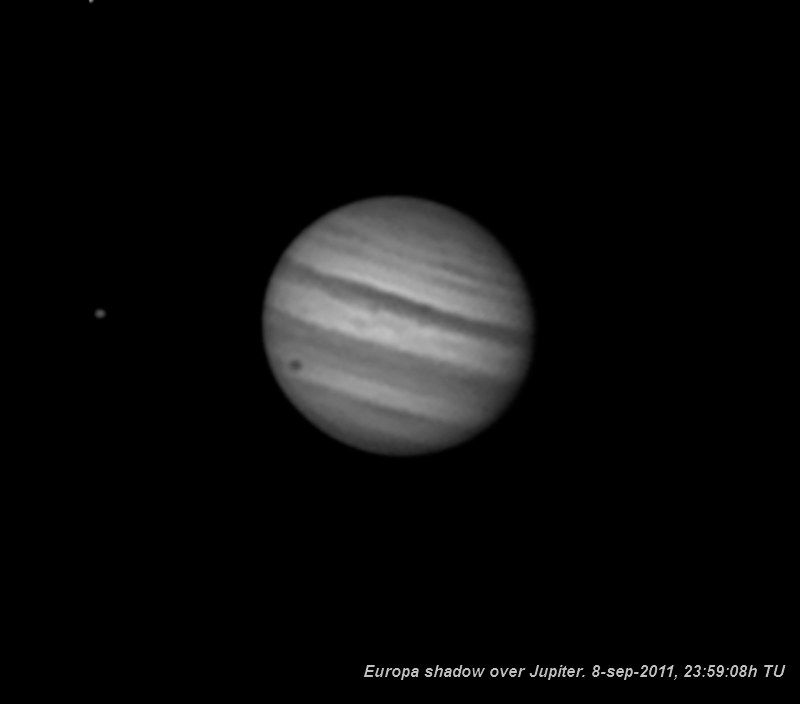| Europa is the moon at the left of Jupiter, and the dark dot on Jupiter surface is the moon shadow crossing over the planet (transit).
Europa or Jupiter II, is the sixth closest moon of the planet Jupiter, and the smallest of its four Galilean satellites, but still one of the largest bodies in the Solar system. Europa was discovered in 1610 by Galileo Galilei and possibly independently by Simon Marius around the same time.
Slightly smaller than Earth's Moon, Europa is primarily made of silicate rock and probably has an iron core. It has a tenuous atmosphere composed primarily of oxygen. Its surface is composed of ice and is one of the smoothest in the Solar System. This surface is striated by cracks and streaks, while craters are relatively infrequent. The apparent youth and smoothness of the surface have led to the hypothesis that a water ocean exists beneath it, which could conceivably serve as an abode for extraterrestrial life. This hypothesis proposes that heat energy from tidal flexing causes the ocean to remain liquid and drives geological activity similar to plate tectonics.
Although only fly-by missions have visited the moon, the intriguing characteristics of Europa have led to several ambitious exploration proposals. The Galileo mission, launched in 1989, provided the bulk of current data on Europa. A new mission to Jupiter's icy moons, the Europa Jupiter System Mission (EJSM), is proposed for a launch in 2020.
 Europa es el objeto situado a la izquierda de Júpiter en esta imagen, y el circulo oscuro en la superficie del planeta es la sobra de la luna atravesando su superficie (tránsito).
En la configuración óptica de esta imagen se ha probado la combinación de un Telextender Vixen f7.5 con una barlow 2x TAL, con buenos resultados.
Europa o Júpiter II, es la sexta luna más cercana del planeta Júpiter, y el más pequeño de sus cuatro satélites galileanos, pero aún uno de los mayores cuerpos del Sistema Solar. Europa fue descubierta en 1610 por Galileo Galilei y de manera independiente, posiblemente por Simon Marius al mismo tiempo.
Un poco más pequeño que nuestra Luna, Europa está hecha principalmente de rocas de silicatos y probablemente tiene un núcleo de hierro. Cuenta con una tenue atmósfera compuesta principalmente de oxígeno. Su superficie está compuesta por hielo y es una de las más lisas en el Sistema Solar. Esta superficie está estriada por grietas y manchas, mientras que los cráteres son relativamente infrecuentes. La aparente juventud y suavidad de la superficie han llevado a la hipótesis de que existe un océano de agua debajo de ella, lo que podría posiblemente servir como una morada para la vida extraterrestre. Este hipótesis propone que la energía térmica a partir de fuerzas de marea hace que el océano permanezca en estado líquido y mantenga actividad geológica similar a la la tectónica de placas.
Aunque sólo misiones de sobrevuelo han visitado la Luna, las intrigantes características de Europa han llevado a presentación de varios ambiciosos proyectos de exploración. La misión Galileo, lanzado en 1989, ofrece la mayor parte de los datos actuales en Europa. Una nueva misión a las lunas heladas de Júpiter, el Europa Jupiter System Mission (EJSM), se propone para un lanzamiento en 2020. |

